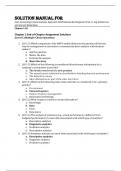Exam (elaborations)
Solution Maunal For Cost Accounting A Data Analytics Approach 2024 Release By Margaret Christ, D. Kip Holderness and Vernon Richardson Chapter 1-10
Solution Maunal For Cost Accounting A Data Analytics Approach 2024 Release By Margaret Christ, D. Kip Holderness and Vernon Richardson Chapter 1-10
[Show more]



